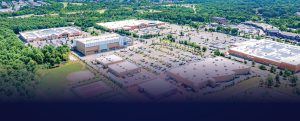Commercial Real Estate
Before the pandemic, commercial and multifamily capitalization rates were at all-time lows, leading to all-time high property valuations. Cap rates continued to fall and were nonetheless appealing given the low yields on alternative investment options. However, as interest rates have risen and other business valuations have decreased, the topic of what will happen to cap rates (and thus property valuations) has resurfaced. Commercial real estate continues to have a positive outlook and investors are keeping an eye on climbing interest rates as the industry shifts into the second half of the year.
Retail Market Overview
U.S. retail property fundamentals kept improving in Q1 2022 as retailers continued to open more stores than they closed. A record level of sales volume was recorded at $23 billion in this year’s first quarter, as investor appetite for well-located retail assets with minimal leasing risk remained robust. Driven by the strength seen over the past two quarters, retail sales volume over the past year has totaled a record high of $99.4 billion, which is up by over 110% on a year-over-year basis. On the other end of the spectrum has been the mall segment. While many Class A malls are back (or near back) to their pre-pandemic selves, the vast majority of suburban B and C malls are struggling to reinvent themselves after the simultaneous loss of both anchor tenants and shoppers. As such, absorption in the mall segment has declined over the past year by 1.7 million square feet.
Net Lease Retail
Investors continued to target single-tenant net lease assets in Q1 and Q2 2022, with sales totaling $13.4 billion and $60.1 billion over the past year, a figure which is higher by 78.5% on a year-over-year basis. With both retail sales and inflation rising, average triple-net asking rents across the U.S. are currently sitting at a record high of $23.00 per square foot. Retail rent growth is forecast to accelerate over the coming quarters due to the combination of a strong retail sales environment and continued rising demand for space.
Shopping Centers
Strip malls are performing best in heavily populated residential areas. Investors remain focused on neighborhood shopping centers (typically with a grocer anchor) in high-growth areas. Sales of neighborhood centers totaled over $5.3 billion in Q1 2022, the strongest first quarter on record for the segment. Over $20 billion of shopping centers have traded hands as of Q2 2022, a 175% increase relative to prior-year sales totals as of this time last year. The success of grocery stores, salons, fast-casual restaurants, and other retailers providing in-person services is helping the market growth.
As Class B and C malls are still struggling, they are now being considered strong candidates for adaptive reuse. Their sites, as well as their accessibility to parking, could be utilized to build market-rate and affordable homes. Many of these shopping malls have dock doors and clear heights that are suitable for industrial usage, making them excellent for warehouses and fulfillment centers.
Multifamily Market Overview
Consumers were particularly hard-hit by price increases in essential goods and services last month. Rent rose by 5.2% over the past 12 months, food increased 10.1%, and “food at home” (groceries) jumped 11.9%. A housing supply shortage and strong labor market continue to underpin strong multifamily fundamentals. However, wage growth is not keeping up with inflation, and savings are being drawn down, which will increasingly strain household budgets and limit renters’ ability to pay higher rents in coming quarters.
Apartment Sales & Rent Fundamentals
The apartment sector had a remarkable recovery in 2021. Not only had the national vacancy rate fully reverted to its pre-pandemic level, but both asking and effective rent also grew. Apartment demand extended its growth in the 1st quarter of 2022, coinciding with a nationwide relaxation of COVID-related restrictions and a consistent increase in the return-to-office rate. While new construction is picking up the pace, a supply and demand imbalance remains, resulting in further market tightness and upward pressure on rents. Although most of the vacancy decline was accumulated during the second half of last year, the additional 10 bps drop this quarter signaled further strength in the sector.
Healthcare Market Overview
The pandemic shone a spotlight on the value of home health, driving increased interest in alternative care models that are more accessible to patients. The healthcare industry is currently booming with high sales volume this year. Care services were down 9% in deal volume in 2021 and have increased by 5% in Q2 2022. Convenient and long-term care continues to be a strong subsector driving transactions. The rise in sales activity can be contributed to creating health systems that can deliver higher quality, patient-centric care anchored with digital capabilities. This has geared ways to expand on-demand care including telemedicine, as well as retail clinics using urgent care for adaptive reuse. Examples include walk-in MRIs, drive-thru pharmacy pick-up locations, and covid testing facilities to “medtail” office buildings taking over vacant retail spaces in metropolitan areas.
Industrial Market Overview
As both e-commerce and brick-and-mortar retailers, along with third-party distributors, have been taking up space to accommodate high-level retail spending, quarterly U.S. industrial leasing has plateaued around 345 million square feet since summer 2021, up 65% from typical quarterly leasing recorded during the three years before the pandemic. Leasing levels have topped out in recent months partly due to the simple fact that there is very little quality space left for tenants to absorb.
At 3.9% as of Q2 2022, the national vacancy rate is at the lowest level ever recorded. Still, given the current economic backdrop, industrial leasing looks likely to remain at very strong levels by historical standards, even as it slows from 2021’s pace. Gains in gas prices and overall inflation would have to continue accelerating and remain persistently high through 2022 and into 2023 to drive a dramatic slowdown in consumer spending.
Investment in U.S. industrial properties has shot up since the initial panic surrounding the pandemic began to subside in late 2020. As of Q2 2022, sales volume totals $129 billion, this is the biggest increase among all property types in the U.S., with apartments not far behind.
Still, given the current economic backdrop, industrial leasing looks likely to remain at very strong levels by historical standards, even as it slows from 2021’s pace. Gains in gas prices and overall inflation would have to continue accelerating and remain persistently high through 2022 and into 2023 to drive a dramatic slowdown in consumer spending.
Self-Storage
Among the top U.S. metros for self-storage development, Florida’s North Port-Sarasota area registers as the highest for new suburban self-storage units. In a similar vein, the Phoenix metro area, one of the fastest-growing regions in the nation, is also adding substantial self-storage square footage in the suburbs, which suits the needs of newcomers to the area, many of them retirees. Other demand drivers include small retailers using space for distribution and individuals who work remotely using storage space for office equipment and furniture to make room for at-home working spaces. The percentage of households that use self-storage has grown to more than ten percent, the highest rate ever, and that percentage is not likely to shrink, industry advocates say.
Prospects for the Remainder of 2022
Most investments have centered around large gateway markets such as New York, Los Angeles, and Chicago, as well as high-growth markets such as Dallas, Atlanta, Phoenix, and Houston. Like retailers, investors have chased population growth-induced tailwinds into fast-growing markets in the South and Southwest.
Several factors will also continue to fuel transaction activity for the remainder of 2022. One is that capital availability from debt and equity funds is at unprecedented levels, likely causing a spike in prices due to competition for assets. Despite the recent rise in rates, this challenge has caused cap rates to compress, specifically in high-demand regions like Southern California. Short-term rentals offer a viable solution in opportunity, profitability, and security for investors, as this asset class provides higher cash flow at relatively affordable pricing in growing markets throughout the U.S.
As interest rate increases, it will almost certainly lead to decelerating sales volume and slower price growth in the U.S. industrial market overall during 2022. However, they won’t likely stop the mountain of capital that has been raised for industrial investment from being deployed, as investors remain drawn to the asset class given its potential for rent growth to exceed or at least keep pace with inflation, as well as the uncertain long-term leasing prospects in other major real estate sectors such as office and retail.









